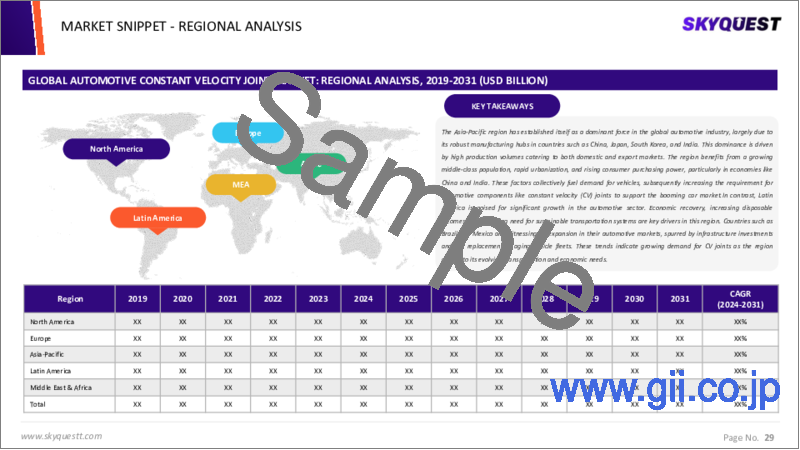|
|
市場調査レポート
商品コード
1569449
自動車用等速ジョイントの市場規模、シェア、成長分析、ジョイントタイプ別、流通チャネル別、車両タイプ別、推進力別、地域別 - 産業予測、2024年~2031年Automotive Constant Velocity Joint Market Size, Share, Growth Analysis, By Joint type, By Distribution Channel, By Vehicle Type, By Propulsion, By Region - Industry Forecast 2024-2031 |
||||||
|
|||||||
| 自動車用等速ジョイントの市場規模、シェア、成長分析、ジョイントタイプ別、流通チャネル別、車両タイプ別、推進力別、地域別 - 産業予測、2024年~2031年 |
|
出版日: 2024年10月13日
発行: SkyQuest
ページ情報: 英文 223 Pages
納期: 3~5営業日
|
全表示
- 概要
- 目次
世界の自動車用等速ジョイントの市場規模は、2022年に32億米ドルとなり、2023年の33億7,000万米ドルから、2031年までには51億4,000万米ドルに成長し、予測期間(2024年~2031年)のCAGRは5.40%で成長する見通しです。
世界の自動車用等速ジョイント(CVジョイント)市場は、主に世界の自動車の生産と販売の増加によって、近年一貫した上昇軌道を遂げています。CVジョイントは、自動車のドライブトレインシステムにおいて重要な部品であり、安定した速度を確保し、エンジンから車輪へのシームレスなエネルギー伝達を促進します。自動車製造の急増に伴い、CVジョイントの需要もそれに応じて高まっています。さらに、自動車技術の進歩、特に電気自動車やハイブリッド車の台頭により、CVジョイントに求められる設計や仕様が変化しています。メーカーは現在、最新の自動車の進化する要求に応えるため、革新的で堅牢かつ効率的なCVジョイントの開発に注力しています。この転換は、自動車セクターにおける性能向上と持続可能性への幅広い動向を反映しており、CVジョイントは従来の自動車にとって重要な部品であるだけでなく、将来の電気自動車やハイブリッド自動車の設計に不可欠な要素でもあります。業界が進化を続ける中、CVジョイント市場は大きな成長を遂げる態勢にあり、より優れた車両性能とエネルギー効率を達成する上でこれらの部品が重要であることを浮き彫りにしています。全体として、自動車用CVジョイント市場は、世界の自動車動向と技術進歩に後押しされ、将来有望な市場になると考えられています。
目次
イントロダクション
- 調査の目的
- 定義
- 市場範囲
調査手法
- 情報調達
- 二次・一次情報源
- 市場規模予測
- 市場の前提条件と制限
エグゼクティブサマリー
- 市場概要見通し
- 供給需要動向分析
- セグメント別機会分析
市場力学と見通し
- 市場力学
- 促進要因
- 機会
- 抑制要因
- 課題
- ポーターの分析
主要な市場の考察
- 技術分析
- バリューチェーン分析
- 市場のエコシステム
- ケーススタディ分析
- 規制情勢
- イノベーションマトリクス
- 主要な投資分析
- 主要な成功要因
- 競合の程度
自動車用等速ジョイント市場:ジョイントタイプ別
- 市場概要
- ルゼッパジョイント
- 三脚ジョイント
- 固定ジョイント・プランジジョイント
- その他
自動車用等速ジョイント市場:流通チャネル別
- 市場概要
- メーカー
- アフターマーケット
自動車用等速ジョイント市場:車両タイプ別
- 市場概要
- 乗用車
- 小型商用車
- 大型商用車
自動車用等速ジョイント市場:推進力別
- 市場概要
- ICE
- 電気・ハイブリッド
- その他
自動車用等速ジョイント市場:地域別
- 市場概要
- 北米
- 米国
- カナダ
- 欧州
- ドイツ
- スペイン
- フランス
- 英国
- イタリア
- その他欧州地域
- アジア太平洋
- 中国
- インド
- 日本
- 韓国
- その他アジア太平洋
- ラテンアメリカ
- ブラジル
- その他ラテンアメリカ地域
- 中東・アフリカ(MEA)
- GCC諸国
- 南アフリカ
- その他中東・アフリカ地域
競合情勢
- 上位5社の比較
- 主要企業の市場ポジショニング(2023年)
- 主要な市場企業が採用した戦略
- 市場における最近の活動
- 主要企業の市場シェア(2023年)
主要企業プロファイル
- ZWZ(China)
- Shandong Huifeng Auto Fittings Co(China)
- Zhejiang ODM Transmission Technology Co. Ltd.(China)
- Wanxiang Qianchao Co. Ltd(China)
- SK(South Korea)
- Nanyang Automobile & Cycle Group(China)
- IFA Rotorion(Germany)
- American Axle Manufacturing Holdings Inc.(US)
- Nexteer Automotive NA(US)
- Neapco Holdings LLC(US)
- NTN Corporation(Japan)
- Hyundai WIA Corporation(South Korea)
- NKN Co. Ltd.(Japan)
- ZF Friedrichshafen AG(Germany)
- JTEKT Corporation(Japan)
- SKF AB(Sweden)
- Schaeffler AG(Germany)
- Dana Incorporated(US)
- Thompson Couplings Limited(Australia)
- Guansheng Auto Parts Co. Ltd.(China)
- Xuchang Yuandong Drive Shaft Co. Ltd.(China)
- Changzhou Guangyang Bearing Co. Ltd.(China)
- GSP Automotive Group(China)
Global Automotive Constant Velocity Joint Market size was valued at USD 3.2 billion in 2022 and is poised to grow from USD 3.37 billion in 2023 to USD 5.14 billion by 2031, growing at a CAGR of 5.40% during the forecast period (2024-2031).
The global Automotive Constant Velocity Joint (CV Joint) market has witnessed a consistent upward trajectory in recent years, driven primarily by the increasing production and sales of vehicles worldwide. CV joints are vital components within vehicle drivetrain systems, ensuring stable velocity and facilitating seamless energy transfer from the engine to the wheels. As automotive manufacturing surges, the demand for CV joints has correspondingly elevated. Additionally, advancements in automotive technology, particularly the rise of electric and hybrid vehicles, are reshaping the design and specifications required for CV joints. Manufacturers are now focusing on developing innovative, robust, and efficient CV joints to cater to the evolving demands of modern vehicles. This shift reflects a broader trend towards enhanced performance and sustainability within the automotive sector, positioning CV joints not only as critical components for traditional vehicles but also as essential elements in the future of electric and hybrid automotive design. As the industry continues to evolve, the CV joint market is poised for significant growth, highlighting the importance of these components in achieving better vehicle performance and energy efficiency. Overall, the Automotive CV Joint market is set for a promising future, fueled by global automotive trends and technological advancements.
Top-down and bottom-up approaches were used to estimate and validate the size of the global automotive constant velocity joint market and to estimate the size of various other dependent submarkets. The research methodology used to estimate the market size includes the following details: The key players in the market were identified through secondary research, and their market shares in the respective regions were determined through primary and secondary research. This entire procedure includes the study of the annual and financial reports of the top market players and extensive interviews for key insights from industry leaders such as CEOs, VPs, directors, and marketing executives. All percentage shares split, and breakdowns were determined using secondary sources and verified through Primary sources. All possible parameters that affect the markets covered in this research study have been accounted for, viewed in extensive detail, verified through primary research, and analyzed to get the final quantitative and qualitative data.
global automotive constant velocity joint Market Segmental Analysis
Global Automotive Constant Velocity Joint Market is segmented by Joint type, Distribution Channel, Vehicle Type, Propulsion, and region. Based on Joint type, the market is segmented into Rzeppa Joints, Tripod Joints, Fixed and Plunge Joints, Others. Based on Distribution Channel, the market is segmented into OEM, Aftermarket. Based on application, the market is segmented into Passenger Car, Light Commercial Vehicle, Heavy Commercial Vehicle. Based on Propulsion, the market is segmented into ICE, Electric and Hybird, Others. Based on region, the market is segmented into North America, Europe, Asia Pacific, Latin America and Middle East & and Africa.
Driver of the global automotive constant velocity joint Market
The continuous expansion of the global automotive industry is a significant market driver for the automotive constant velocity joint (CV joint) market, as increasing vehicle production and sales across multiple segments fuel demand. The growing consumer preference for automobiles, propelled by rising disposable incomes and urbanization, intensifies the need for efficient drivetrain systems, where CV joints are essential for ensuring smooth power transfer and handling performance. Furthermore, the shift towards electric and hybrid vehicles necessitates advanced CV joint technologies to accommodate new drivetrain requirements, thereby expanding market opportunities. This robust growth trajectory underscores the critical role of CV joints in the automotive ecosystem.
Restraints in the global automotive constant velocity joint Market
The global automotive constant velocity joint market faces significant restraints due to the cyclical nature of the automobile industry, which is often vulnerable to economic downturns and financial instability. During periods of economic uncertainty, consumers tend to postpone vehicle purchases, leading to a notable decrease in demand for CV joints. Furthermore, the market is adversely affected by the volatility in raw material prices, particularly for essential components such as steel and alloys used in CV joint production. Fluctuations in these costs can directly influence manufacturing expenses and profit margins, ultimately constraining the growth potential of the CV joint market.
Market Trends of the global automotive constant velocity joint Market
The global automotive constant velocity joint market is currently experiencing a significant trend towards sustainability and efficiency, driven by increasing global initiatives aimed at reducing carbon emissions. This shift has escalated the demand for CV joints that cater to the requirements of electric and hybrid vehicles, spurring advancements in joint design and materials that enhance performance and durability. Additionally, there is a noteworthy surge in demand for lightweight components across the automotive sector, as manufacturers prioritize fuel efficiency and overall vehicle performance. This convergence of trends is reshaping the landscape of the CV joint market, emphasizing innovation and eco-conscious practices.
Table of Contents
Introduction
- Objectives of the Study
- Definitions
- Market Scope
Research Methodology
- Information Procurement
- Secondary & Primary Data Sources
- Market Size Estimation
- Market Assumptions & Limitations
Executive Summary
- Market Overview Outlook
- Supply Demand Trend Analysis
- Segmental Opportunity Analysis
Market Dynamics & Outlook
- Market Dynamics
- Drivers
- Opportunities
- Restraints
- Challenges
- Porters Analysis
- Competitive rivalry
- Threat of Substitute Products
- Bargaining Power of Buyers
- Threat of New Entrants
- Bargaining Power of Suppliers
Key Market Insights
- Technology Analysis
- Value Chain Analysis
- Ecosystem of the Market
- Case study Analysis
- Regulatory Landscape
- Innovation Matrix
- Top Investment Analysis
- Key Success Factor
- Degree of Competition
Automotive Constant Velocity Joint Market by Joint type
- Market Overview
- Rzeppa Joints
- Tripod Joints
- Fixed and Plunge Joints
- Others
Automotive Constant Velocity Joint Market by Distribution Channel
- Market Overview
- OEM
- Aftermarket
Automotive Constant Velocity Joint Market by Vehicle Type
- Market Overview
- Passenger Car
- Light Commercial Vehicle
- Heavy Commercial Vehicle
Automotive Constant Velocity Joint Market by Propulsion
- Market Overview
- ICE
- Electric and Hybird
- Others
Automotive Constant Velocity Joint Market Size by Region
- Market Overview
- North America
- USA
- Canada
- Europe
- Germany
- Spain
- France
- UK
- Italy
- Rest of Europe
- Asia Pacific
- China
- India
- Japan
- South Korea
- Rest of Asia-Pacific
- Latin America
- Brazil
- Rest of Latin America
- Middle East & Africa (MEA)
- GCC Countries
- South Africa
- Rest of MEA
Competitive Landscape
- Top 5 Player Comparison
- Market Positioning of Key Players, 2023
- Strategies Adopted by Key Market Players
- Recent Activities in the Market
- Key Companies Market Share (%), 2023
Key Company Profiles
- ZWZ (China)
- Company Overview
- Business Segment Overview
- Financial Updates
- Key Developments
- Shandong Huifeng Auto Fittings Co (China)
- Company Overview
- Business Segment Overview
- Financial Updates
- Key Developments
- Zhejiang ODM Transmission Technology Co. Ltd. (China)
- Company Overview
- Business Segment Overview
- Financial Updates
- Key Developments
- Wanxiang Qianchao Co. Ltd (China)
- Company Overview
- Business Segment Overview
- Financial Updates
- Key Developments
- SK (South Korea)
- Company Overview
- Business Segment Overview
- Financial Updates
- Key Developments
- Nanyang Automobile & Cycle Group (China)
- Company Overview
- Business Segment Overview
- Financial Updates
- Key Developments
- IFA Rotorion (Germany)
- Company Overview
- Business Segment Overview
- Financial Updates
- Key Developments
- American Axle Manufacturing Holdings Inc. (US)
- Company Overview
- Business Segment Overview
- Financial Updates
- Key Developments
- Nexteer Automotive NA (US)
- Company Overview
- Business Segment Overview
- Financial Updates
- Key Developments
- Neapco Holdings LLC (US)
- Company Overview
- Business Segment Overview
- Financial Updates
- Key Developments
- NTN Corporation (Japan)
- Company Overview
- Business Segment Overview
- Financial Updates
- Key Developments
- Hyundai WIA Corporation (South Korea)
- Company Overview
- Business Segment Overview
- Financial Updates
- Key Developments
- NKN Co. Ltd. (Japan)
- Company Overview
- Business Segment Overview
- Financial Updates
- Key Developments
- ZF Friedrichshafen AG (Germany)
- Company Overview
- Business Segment Overview
- Financial Updates
- Key Developments
- JTEKT Corporation (Japan)
- Company Overview
- Business Segment Overview
- Financial Updates
- Key Developments
- SKF AB (Sweden)
- Company Overview
- Business Segment Overview
- Financial Updates
- Key Developments
- Schaeffler AG (Germany)
- Company Overview
- Business Segment Overview
- Financial Updates
- Key Developments
- Dana Incorporated (US)
- Company Overview
- Business Segment Overview
- Financial Updates
- Key Developments
- Thompson Couplings Limited (Australia)
- Company Overview
- Business Segment Overview
- Financial Updates
- Key Developments
- Guansheng Auto Parts Co. Ltd. (China)
- Company Overview
- Business Segment Overview
- Financial Updates
- Key Developments
- Xuchang Yuandong Drive Shaft Co. Ltd. (China)
- Company Overview
- Business Segment Overview
- Financial Updates
- Key Developments
- Changzhou Guangyang Bearing Co. Ltd. (China)
- Company Overview
- Business Segment Overview
- Financial Updates
- Key Developments
- GSP Automotive Group (China)
- Company Overview
- Business Segment Overview
- Financial Updates
- Key Developments





